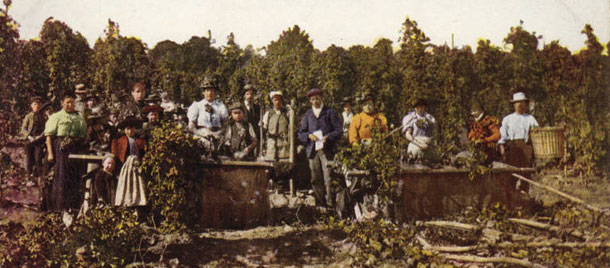
The good news is that this headline is pretty stupid: “IPA Lovers Beware: Beer Prices Could Skyrocket Next Year Thanks to Drought.”
The not so good news is that this one is more accurate: “Trouble Brewing: Drought-Hit Hops Crop Concerns Craft Beer Brewers.” And the story that goes with it is well reported and more complete.
That hop prices must go up if growing breweries are going to continue to use the varieties of hops they are in the manner they are is not news (see this explanation from last January). However, lack of water in the state of Washington, an unsually hot late spring/early summer in the American northwest, and a not-so-great growing season in Europe are about to remind us that beer is an agricultural product.
Earlier this week, Otmar Weingarten of the German Hop Growers Association told the those attending International Hop Growers Congress in Bavaria that production in Germany’s main hop growing regions would likely fall 12 to 22 percent short of earlier predictions. And Ann George, executive director of the Hop Growers of America, said that US alpha varieties yield would be down up to 5 percent and aroma varieties off 10 to 15 percent. There’s bound to be variation from region to region and variety to variety. For instance, best guess is that Centennial yields, also disappointing in 2014, could be 20 percent short of expectations.
That is bad news for brewers without contracts who were hoping for a bumper crop (so they could buy the excess). And it means you’ll see more stories about hop shortages as harvest begins next month and rolls into fall. But this is not the hop shortage of 2007 and 2008, one that was a big enough deal to merit an entry in “The Oxford Companion to Beer.” Then a combination of events led to an alpha shortage that became obvious after the 2006 harvest. In 2005, the “spot” price, one that brewers without contracts for some or all of the hops they needed would pay, was $1.95 to $2.80 per kg alpha. A pound of Cascade cost $1.65 to $1.75. By the end of the 2007 harvest the shortage was so extreme that most un-contracted hops sold for $198 to $220 per kg alpha and some ticked as high as $992. The price of a pound of Cascade climbed to $30.
Right now there remains an alpha surplus. I should probably write a primer about what this means, but just the basics for now. Most of the world’s largest breweries use hop extract to brew their beers and treat alpha as a commodity. They don’t use a lot for any individual beer, but they use a lot of hops. They like paying low prices, but as we saw in 2007 when they need to they have the money to spend whatever they must. So if alpha gets out of balance, and particularly given the structural change that has taken place, then all bets are off.
Does drought also have an effect on the quality of the hops that are harvested?
Yes. It may result in lower levels of alpha acids (kind of a second level of yield for those buying alpha only). It also may affect oil levels, and oils produce the odor compounds that have helped drive demand for hop-forward beers.
So not just less intense but potentially off the anticipate taste and aroma profiles?
Brewers at larger companies will go to the hop growing regions and be able to select what they want – with the understanding that what they smell right after harvest does not translate perfectly to aroma in beer. Those too small to make their own selections will need to be paying a lot more attention.
That’s where the skill of the brewer comes in – in other words knowing more about hops that just “add more.” To draw an analogy, I think back to a conversation with Bernard Kuhn at Weissbräu Freilassing. He was talking about wheat malt, but what he says includes hops as well. “You cannot always do the same process because every year the malt is different. You have to brew good beer out of shitty malt. That’s the skill of the brewmaster.”
Interesting. So potentially a crop that further enhances the distance between the best and worst craft brewers.
Or perhaps the most discerning and the least discerning drinkers.
Nice article! I too attended the IHGC in Bavaria earlier this week. There were quite a few reports with similar information as presented by Mr. Weingarten, but that is only the tip of the iceberg. I just wrote about this in our blog today coincidentally. You can check it out at: http://www.47hops.blogspot.com
Doug
And the patient’s condition has just been upgraded slightly (depending on how you look at it) http://www.columbian.com/news/2015/jul/29/bigger-hop-harvest-expected-despite-drought/?utm_source=twitterfeed&utm_medium=twitter
Thanks, Bob. Somebody needs to create a hop harvest app.